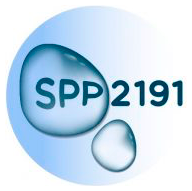The nuclear pore complex (NPC) is a ~120 MDa complex built from multiple copies of ~30 different nucleoporins (Nups). The NPC traverses the nuclear envelope and functions as “gatekeeper” for nucleocytoplasmic transport. The NPC’s permeability barrier consists of ~10 different “FG-Nups”, primarily disordered Nups containing domains rich in phenylalanine (F) and glycine (G). These FG-domains non-covalently interact to form a supramolecular matrix of elusive structure in the NPC’s central region. A promising approach to study the permeability barrier is to develop in vitro reconstitution models of FG-Nups that capture key features of the functional NPC, i.e. cargoes bigger than ~ 4nm cannot penetrate the barrier, unless they are bound to nuclear transport receptors (NTRs). We have now developed a microfluidic device, on which we can show that FG-Nups can populate a liquid like state (following liquid phase separation, LLPS). Surprisingly, it mimics well some functionality of a physiological permeability barrier. Namely, large cargoes can undergo facilitated import into the droplet only when a functional NTR:cargo complex can be formed.
To investigate how this liquid FG-Nup permeability barrier functions, we now aim to build a unique “multi-analytic” platform that integrates microfluidics with coherent anti-Stokes Raman spectroscopy (CARS) and particle tracking microrheology (PTM), to study the evolving supramolecular structure as well as the mechanical properties of FG-rich droplets. The microfluidic device allows for controlled addition of NTRs into the FG-Nup solution at any stage during LLPS. To interpret experimental observations and to provide fundamental physical insight, we supplement our experimental efforts with multi-component phase field modeling of LLPS. This method allows access to macroscopic time and length scales and is therefore highly compatible with the spatiotemporal regime associated with the in vitro experimentation.
This project will significantly advance insight into the barrier function of FG-Nups exhibiting liquid-like and/or transient elastic behavior in the condensed state. Moreover, the platform we build will serve as a general tool to study LLPS of phase separating proteins, in particular those that undergo rapid maturation to gel or amyloid like states.
The ratiometric image series of how M9-MBP-GFP does not enrich in FG-Nup49 droplets in the presence of Importin β. Scale bar, 50 μm. Frame rate, 10 frames/s.
Giorgia Celetti, Giulia Paci, Joana Caria, Virginia VanDelinder, George Bachand, Edward A. Lemke; The liquid state of FG-nucleoporins mimics permeability barrier properties of nuclear pore complexes. J Cell Biol 6 January 2020; 219 (1): e201907157. doi: https://doi.org/10.1083/jcb.201907157
Side-by-side FG-Nup49 channel (left) and M9-MBP-GFP channel (right), revealing a rim stain of the cargo. Scale bar, 20 μm. Frame rate, 5 frames/s.
Giorgia Celetti, Giulia Paci, Joana Caria, Virginia VanDelinder, George Bachand, Edward A. Lemke; The liquid state of FG-nucleoporins mimics permeability barrier properties of nuclear pore complexes. J Cell Biol 6 January 2020; 219 (1): e201907157. doi: https://doi.org/10.1083/jcb.201907157
Edward Lemke
The Lemke lab is a multidisciplinary group of chemists, physicists, biologists and engineers interested in understanding molecular mechanisms that are driven by disorder. We develop biophysical tools to visualize molecular mechanisms in vitro and in cells with the highest combined temporal and spatial resolution and we innovate synthetic biology approaches to tune, control and study molecular and cellular processes.
Adjunct Director
Institute of Molecular Biology
Departments of Biology and Chemistry, Pharmacy and Geosciences
Johannes Gutenberg University Mainz
Hanns-Dieter-Hüsch-Weg 17
55128 Mainz, Germany
Jasper J. Michels
A primary focus of the Michels lab is modeling and simulation of phase transitions in multicomponent mixtures, such as polymer solutions and protein mixtures. These may be liquid-liquid (LL), as well as liquid-solid (LS) transitions. In particular, we are interested in translating molecular properties into macroscopic behavior in order to model the transitions on the level of single cells, cell colonies, as well as in-vitro experiments. We extend classical theory towards the inclusion of specific interaction sites on (protein) chains, which critically influence the phase behavior and its dynamics.
Max Planck Institute for Polymer Research
Molecular Electronics Division
Ackermannweg 10
55128 Mainz
Germany
Sapun Parekh
The Parekh lab focuses broadly on molecular microscopy and molecular
biophysics, and phase separation is one of the primary topics. We study both protein and lipid phase separation, specifically the interactions that stabilize different phases using chemical microscopy and solution properties of the phases using fluorescence correlation spectroscopy and particle tracking microrheology. Our goals are to understand how the chemical and solution environment in phase separated domains are modified with time and with addition of molecular cargos.
Molecular Spectroscopy Department
Max Planck Institute for Polymer Research
&
Department of Biomedical Engineering
University of Texas at Austin

